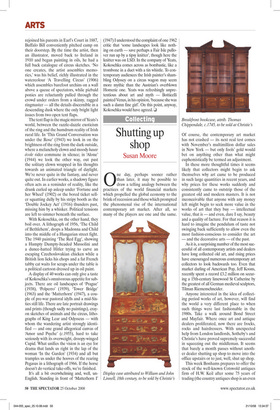Dashing pair
Laura Gascoigne
Jack B. Yeats & Oskar Kokoschka Compton Verney, until 14 December
In 1962 Oskar Kokoschka drew record crowds to his Tate retrospective — belated recognition for the Austrianborn artist who had lived in London, on and off, since 1938. Herbert Read blamed the long delay on Kokoschka’s ‘un-Englishness’, so it’s ironic that his latest comeback should be at that most English of galleries, Compton Verney, in a double bill with another un-English artist still awaiting due recognition in this country: the Irish painter Jack Butler Yeats.
Oskar Kokoschka: Exile and New Home 1938–1980 comes to Compton Verney from the Albertina, Vienna; Jack B. Yeats, Masquerade and Spectacle: The Circus and the Travelling Fair from the National Gallery of Ireland. The two artists knew and admired each other. Both loved juicy paint and rampant colour; both were dramatists who also wrote plays, and humanists who also happened to excel at painting horses. And both were interested in the circus, though for Yeats this was a lifelong obsession, whereas for Kokoschka it was just another colourful subject.
Yeats fell in love with the travelling circus as a child in Sligo where he lived with his grandparents until age 15; when he rejoined his parents in Earl’s Court in 1887, Buffalo Bill conveniently pitched camp on their doorstep. By the time the artist, then an illustrator, moved back to Ireland in 1910 and began painting in oils, he had a full back catalogue of circus sketches. ‘No one creates, the artist assembles memories,’ was his belief, richly illustrated in the watercolour ‘A Travelling Circus’ (1906) which assembles barefoot urchins on a wall above a queue of spectators, while piebald ponies are reluctantly pulled through the crowd under orders from a skinny, ragged ringmaster — all the details discernible in a descending dusk where the only bright light issues from two open tent flaps.
The tent flap is the magic mirror of Yeats’s world, between the razzle-dazzle exoticism of the ring and the humdrum reality of Irish rural life. In ‘This Grand Conversation was under the Rose’ (1943) we look in on the brightness of the ring from the dark outside, where a melancholy clown and moody haute école rider commune in silence; in ‘Alone’ (1944) we look the other way, out past the solitary clown wrapped in his thoughts towards an animated triangle of daylight. We’re never quite in the fantasy, and never quite out. In earlier works, a shadowy figure often acts as a reminder of reality, like the drunk curled up asleep under ‘Fortune and her Wheel’ (1902) or the bored ticket seller squatting dully by his stripy booth as the ‘Double Jockey Act’ (1916) thunders past, missing him by a whisker. Political tensions are left to simmer beneath the surface.
With Kokoschka, on the other hand, they boil over. A lithograph of 1956, ‘The Child of Bethlehem’, drops a Madonna and Child into the middle of a Hungarian street fight. The 1940 painting ‘The Red Egg’, showing a Humpty Dumpty-headed Mussolini and a dunce-hatted Hitler trying to carve an escaping Czechoslovakian chicken while a British lion licks his chops and a fat French tabby cat waits for scraps under the table is a political cartoon dressed up in oil paint.
A display of 40 works can only give a taste of Kokoschka’s omnivorous appetite for subjects. There are oil landscapes of ‘Prague’ (1938), ‘Polperro’ (1939), ‘Tower Bridge’ (1963) and the ‘Matterhorn’ (1947), a couple of pre-war pastoral idylls and a mid-Sixties still life. There are late portrait drawings and prints (though sadly no paintings), crayon sketches of animals and the circus, lithographs of King Lear and Odysseus — with whom the wandering artist strongly identified — and one grand allegorical canvas of ‘Amor und Psyche’ (c.1955), hard to take seriously with its overweight, droopy-winged Cupid. What unifies the vision is an eye for drama that lands us right in the lap of the woman ‘In the Garden’ (1934) and all but tramples us under the hooves of the rearing Pegasus in a lithograph of 1966. If the horse doesn’t do vertical take-offs, we’re finished.
It’s all a bit overwhelming and, well, unEnglish. Standing in front of ‘Matterhorn I’ (1947) I understood the complaint of one 1962 critic that ‘some landscapes look like nothing on earth — save perhaps a Fair Isle pullover run up by a tipsy knitter’, though here the knitter was on LSD. In the company of Yeats, Kokoschka comes across as bombastic, like a trombone in a duet with a tin whistle. To contemporary audiences the Irish painter’s shambling Odyssey on a circus wagon may seem more mythic than the Austrian’s overblown Homeric one. Yeats was refreshingly unpretentious about art and myth — Botticelli painted Venus, in his opinion, ‘because she was such a damn fine girl’. On this point, anyway, Kokoschka would have agreed. ❑



















































































 Previous page
Previous page